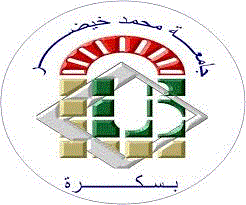| Titre : | Extraction of pectins from orange and lemon peels |
| Auteurs : | Fouzia Bacha, Auteur ; Adel Boumedjene, Directeur de thèse ; Aissam Boukraa, Directeur de thèse |
| Type de document : | Mémoire magistere |
| Editeur : | Biskra [Algérie] : Faculté des Sciences Exactes et des Sciences de la Nature et de la Vie, Université Mohamed Khider, 2025 |
| Format : | 1VOL.(48p) / ill.couv.ill.en coul / 30cm |
| Langues: | Anglais |
| Langues originales: | Anglais |
| Résumé : |
Given the availability of raw materials (oranges, lemons, mandarins, apples, and apricots) and the byproducts discarded following the development of fruit processing in our country, it is important to explore the possibility of producing pectins, rather than paying for them in foreign currency. Our research focused on the following points: Extracting pectins from medium-ripe orange, lemon, and mandarin peels by acid hydrolysis (hydrochloric acid) under the same conditions (pH, temperature, and time). Determining the physicochemical and structural characteristics of the peels and pectins, as well as their functional properties in relation to their structurtheir AGA, DE, and methoxyl group contents. The physicochemical indices, namely dry matter, water content, ash content, mineral content, and organic matter content, show some discrepancy compared to the literature due to the poor ripeness of the citrus fruits used. The results obtained show that the yields are almost equal and vary between 58.57% (for mandarin) and 50.2% (for lemon) for a pH of 1.5 and a temperature of 90°C. For time and temperature, these two parameters also influence pectin yield, but to a lesser extent compared to pH. The AGU, DE, and methoxyl group contents are not far from the normal values, where mandarin peel pectins are at their best. Infrared spectroscopy diagnosis indeed demonstrated the formation of pectins. |
| Sommaire : |
1.By-products(Waste) 04 1.1.Definition 04 1.2. Classification 05 2-Valorization of agro-industrial residues 05 2.1. Orange by-products 06 2.1.1.Composting 06 2.1.2.Extraction ofbioactive compounds 07 2.1.3.Food and Beverages 07 2.1.4.Use as animal feed 07 2.1.5.Biogas production 07 2.1.6.Biodegradable materials 07 2.1.7.Use in cosmetics 07 2.1.8.Structure of the orange peel 07 2.1.9. Chemical composition of orange peel 08 2.2. Lemon by-products 10 2.2.1. Structure of the lemon peel 10 2.2.2.Chemical composition of lemon peel 11 REFERENCES 12 CHAPTER II GENERAL INFORMATION ABOUT PECTIN 1. Structure of pectins 15 1.1. Homogalacturonan 16 1.2. Rhamnogalacturonan 17 1.2.1. Rhamnogalacturonan I 17 1.2.2. Rhamnogalacturonan II 17 1.2.3. Xylogalacturonan 18 2. Types of pectins 19 3. Location of pectins 20 4. Physico-chemical properties 21 4.1. Solubility and precipitation 21 4.2. Stability and degradation 21 4.3. Viscosity 23 4.4. Emulsification 23 4.5. Gelling 23 4.5.1. Gelling of highly methylated pectins 23 4.5.2. Gelling of weakly methylated pectins 24 4.6. Molecular weight 24 5. Uses of pectins 25 5.1. Pectin as encapsulation matrix. 25 5.2. Use of pectins in the field of biomaterials 25 6. Extraction of pectins 26 6.1. Physico-chemical methods 26 6.2. Activated physico-chemical methods 27 6.3. Enzymatic methods 27 7. Mechanism and kinetics of pectin extraction 28 7.1.Dosage of pectins 28 7.1.1Co lorimetric assay 28 7.1.2Determination by chromatography 29 REFERENCES 30 1 . MATERIALS 40 1.1 Chemical products 40 1.2Used glass ware and tools 41 2. Extraction of Pectins 41 2.1.Preparation of the raw material 41 2.1.1. Drying 42 2.1.2. Grinding 42 2 .1.3. Sieving 42 2. 2.Extraction of pectin by hydrochloric acid 42 3. Determination of the physicochemical indices of the peels 44 3.1. Determination of the dry matter 44 3.2. Ash content 44 3. 3. Water contaent 44 3. 4. Mineral matter content 44 3 .5. Organic matter content 45 4.Physicochemical analyses of pectins 45 4. 1. Equivalent weight 45 4.2.Methoxy content 46 4.3. Galacturonic acid content 46 4.4. Degrees of esterification 47 4.5. Solubility of pectin 47 1.Physicochemical indices of the different peels 49 1.1.Dry matter 49 I.2.Water content VS the dry matter content 50 1.3.Ash content and mineral matter contents 51 1.4.Determination of the Organic Matter Content 52 2.Yield of extracted pectins 53 2.1.Parameters influencing the renedement in pectins 53 3. Analysis of the values of galactoronic acid ,methoxy and the degree of esterification 59 4.Diagnosis by FTIR spectroscopy of pectins 62 REFERENCES 67 GENERAL CONCLUSION 70 ANNEX 72 ABSTRACT 76 |
| Type de document : | Mémoire master |
Disponibilité (1)
| Cote | Support | Localisation | Statut |
|---|---|---|---|
| MCH/691 | Mémoire master | bibliothèque sciences exactes | Consultable |





